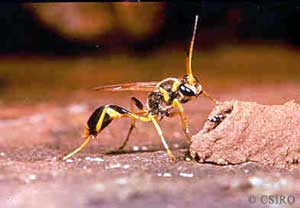
|
SPHECIDAE Sand Wasps or Mud Daubers |
|
| ||||||||||||
|
Sphecids are a large family of wasps commonly known as mud daubers and sand wasps. They are medium to large, with long legs and range in size from 15 to 40 millimetres in body length. These wasps are usually solitary, predatory species that prey on a variety of insect orders and spiders that are used as food for the developing larvae. Prey may include such things as grasshoppers, beetles or spiders with the size of prey usually depending on the size of the wasp.
Nests vary depending on the species and may include various mud constructions, nests dug in sandy soil, natural openings such as holes in wood or even the handles of garden tools, while some wasps utilise the burrows of their hosts.
For more sand wasps or mub dauber species visit the Australian Insect Common Names - Sphecidae section found here. |


